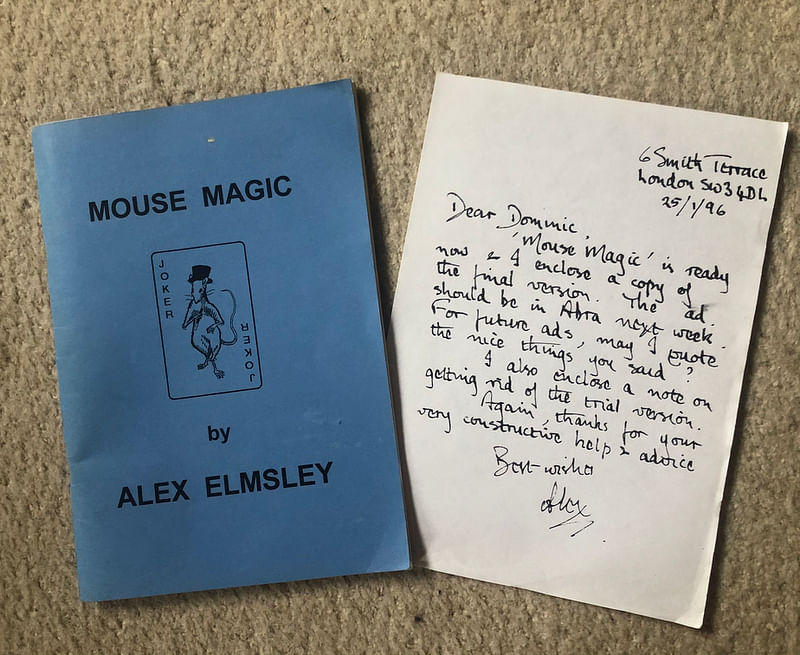Elmsley’s Mouse Tale
By Dominic Twose - Wednesday, August 11, 2021
In 1995, a letter came through my letterbox. (Kids – a ‘letter’ was the way people wrote to each other before email.) In it was a floppy disk. (Kids – a floppy disc was the way people used to send electronic files to each other before CD-ROMS.) (Kids – CD-ROMs were the way people used to send electronic data to each other before Flash Drives.)
The letter was from Alex Elmsley. Alex was a legend among close-up magicians. In what passes for real life he was a computer expert, but he had a genius for magic. He came up with the Elmsley Count, sure; but he also developed hundreds of clever and unique concepts, moves and tricks which were eventually published by L&L in two massive volumes in 1991 and 1994. And the thing about him was that he was such a recluse he made hermits look sociable.
So why was he writing to me?
I’d met him once, when I was still young and inexperienced, in the company of Roy Walton and Fred Robinson. We sat together one evening in the Marlborough Arms, drinking, and talking magic. I’m slightly embarrassed to admit I asked him about the Elmsley Count; I asked what he thought were the best effects that used it. Roy said he thought the best was still Alex’s "Four Card Trick". Alex was demure – but didn’t disagree. After that I wrote to him occasionally, and, bafflingly, he replied.

This particular letter was by means of a follow up to a letter I’d sent him, where I included a trick up with which I’d come. Someone had told me that Alex had come up with something similar, so I wanted to check I wasn’t inadvertently copying something of his; he had written back to say he’d published nothing like it, but was currently working on something that used the same principle.
The floppy disk contained a beta test of "Mouse Magic". (Old guys – a beta test is an early software release to a small group, in order that they test the programme and identify bugs and errors.) "Mouse Magic" wasn’t the first set of tricks designed purely to work on your computer, but it was certainly ingenious. It contained six tricks that you’d swear demonstrated that the computer could read your mind. The excitement of having something totally new – and brilliant – from Alex Elmsley was one highlight of 1995 (only ‘one’? Well, yes, my second daughter was born that year). And one of the tricks used the principle that I’d shared with Alex some time before.
So I tested it, gave Alex my feedback, and in 1996, "Mouse Magic" was released to the world. It was rightly widely acclaimed: Richard Kaufman in The Looking Glass called it ‘wonderful’; Michael Close gave it a very enthusiastic review in Magic magazine, saying that receiving it ‘made my day’; while Max Maven wrote in Genii that it was ‘simply superb’.
It was so good, that Tenyo released an updated version on CD-ROM ("Cyber Conjurer") and Nintendo released a souped-up version for their DS ("Master of Illusion"). (Kids – the Nintendo DS was a handheld game console, discontinued in 2013.)
Alex died in 2006 of a heart attack, and we lost a gentle and brilliant man.
And today? The software on the floppy disk and CD-ROM doesn’t work in today’s computers. The DS is a museum piece. And, well, Alex’s "Mouse Magic" is no longer available. I wrote in an earlier blog about the Jack Pot trick, how it disappeared, but is now available again. This story doesn’t have the same happy ending.
"Mouse Magic" doesn’t even get a mention on Alex’s pages on either Wikipedia or the Genii Magicpedia site. It’s a pity, because the tricks that astonished people then would astonish still. However, the underlying principle of secretly coding the card to the computer whilst seemingly doing something else, lives on in many effects.
On the other hand, ironically, my trick, which was based on one of the principles that Alex used but which doesn’t rely on electronic wizardry and so really should be outdated, is still available, and still effective – it’s called "The Sign of Five".
Back to blog homepage
Similar posts on the blog:

